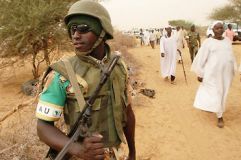AU Darfur monitors await reinforcement as violence continues
ZAM ZAM IDP CAMP, Sudan, June 8 (AFP) — Peering intently from behind tinted sunglasses, a machine gun at his side, an African Union soldier ambles through a human maze in this camp for internally displaced persons (IDPs) in Sudan’s war-ravaged western Darfur region.

|
|
An African Union (AU) soldier stands guard at the Zam Zam refugee camp in Darfur. (AFP). |
Never more than 30 meters (33 yards) from a group of visiting dignitaries and keeping a watchful eye on the guests, Emmanuel, a Rwandan member of the soon-to-be expanded AU Mission in Sudan (AMIS), is here to protect thousands of refugees who have fled their homes fearing violence in volatile Darfur.
Yet as a steady stream of civilians pour into the already crowded Zam Zam camp, currently home to 30,000 IDPs, amid increasingly dire reports of rape and other atrocities, he and his colleagues anxiously await reinforcement.
“We don’t have enough troops to offer protection,” said one AU soldier, who like Emmanuel, is not authorized to speak to reporters. “Even if we are told that someone has been raped, we just go, but we can’t do anything.
“We cannot punish or arrest those responsible,” he says. “We write reports.”
“Even these old women have been raped,” the AU soldier laments as a speeding truck engulfs a group of elderly women in clouds of dust.
Although officials at Zam Zam and elsewhere say fighting between Darfur’s two rebel groups, Khartoum’s army and government-backed militia has diminished since AMIS deployed here in August last year, violence against the region’s civilian population continues, exacerbating already difficult humanitarian conditions.
Alarmed, the AU plans to expand its mission from 2,700 soldiers and police to 7,700 in the next three months, backed by the international community which last month pledged nearly 292 million dollars (233 million euros) to assist the revitalized force at a donors conference in Addis Ababa.
The new assistance, including helicopters, trucks, logistical support and airlift from the European Union, NATO and individual nations, coupled with the resumption in stalled AU-sponsored peace talks this week in Nigeria may give a significant boost to AMIS and its efforts to stabilize the situation.
About 21 kilometers (16 miles) away from Zam Zam at the headquarters of the AU mission in El Fasher, the capital of Sudan’s North Darfur state, AMIS commander Festus Okonkwo sees the arrival of additional troops and materiel as key to protecting civilians and AU observers monitoring a shaky truce.
“The issue is that we are supposed to fight them, now we don’t have that equipment, by the end of September we should have this equipment,” he says, overlooking an array of more than 100 new vehicles that have already arrived.
“If we are able to be given these supplementary forces, we should be able to solve half of these problems,” says Okonkwo, the Nigerian general in charge of the mission that covers a region the size of France.
“We need to be everywhere where the Sudanese soldiers are,” he said. “That will change a lot of things, because right now they are afraid of us. When they see us they stop.”
Troops under his command agree wholeheartedly, citing anecdotal evidence that the presence of AU soldiers is a significant deterrent for fighters intending to violate an oft-broken April 2004 ceasefire.
“In Tawila, almost every night the soldiers fire at the camps, one time, they lobbed a mortar shell,” said one AU soldier, referring to a camp some 85 kilometers (53 miles) south of El Fasher. “They only stop when we are there.”
Darfur has been embroiled in conflict since February 2003, when rebels revolted against Khartoum, charging the Arab-led government had marginalized and persecuted the region’s black African tribes.
In a subsequent crackdown, pro-government militias attacked local communities, murdering, raping and maiming civilians and driving more than 1.6 million people from their homes, according to the United Nations.
The combined effect of the war and a devastating humanitarian crisis has left tens of thousands of people dead in 2004 alone.
